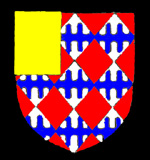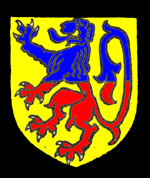Aspley Manor

Coat of arms of the Barony of Bedford
The first mention of land at Aspley Guise comes, not in Domesday Book, but in a charter of King Edgar of 969 when the parish is said to contain 15 hides. In the Domesday Book of 1086 the overlord of Aspley was Hugh de Beauchamp, later Baron of Bedford. The manor remained under the overlordship of the Barony of Bedford until it is last mentioned in the 16th century.
The tenant of the manor at Domesday Book was one Acard de Ivri. No trace of the tenancy is then found in the historical record until 1203 when the tenant under the overlordship of the Barony of Bedford was Guy de Valery, it is known that de was a great-grandson of Ralph de Ivri, who was a contemporary of Acard de Ivri. Guy was succeeded by his son Reginald from whom the infamous Falkes de Breaute, "Robber Baron of Bedford Castle" held the manor for a fixed term. In 1225 de Breaute's estates were confiscated and the remainder of the term of the sub-lease was given to Henry Capella by King Henry III (1216-1271).
In 1227 Reginald de Valery released the manor to Hubert de Burgh, Earl of Kent and Justiciar of England. Hubert fell from favour with the young King Henry III, for whom he acted as regent, and his enemies at court managed his imprisonment in 1332 at which time Aspley Manor was confiscated and granted, the folowing year, to Robert Passelewe. In 1234 de Burgh's estates, including Aspley, were restored. He died in 1243 and his widow, who succeeded him, died in 1259, Aspley passing to his son by a former wife, John.

The Guise family coat of arms
By 1267 John de Burgh had subinfeudated (basically, sublet) Aspley to Anselm de Gyse or Guise, from whom the village takes part of its name. John de Burgh died without a son and the tenancy of Aspley under the overlordship of the Barony of Bedford passed to his daughter Hawise, wife of Robert de Gresley. Their daughter Joan married John de la Warr and Aspley Manor was in their hands by the middle of the 14th century. After this date the descendants of Hubert de Burgh seem to have no further interest in the manor, their former tenants, the de Gyses, holding Aspley directly from the Barony of Bedford. Anselm de Gyse died in 1295. The manor remained in the family, first being called Aspley Guise Manor in 1375, until 1540 when John Gyse exchanged Aspley Guise for lands in Gloucestershire, near his estates at Elmore.
In 1541 Henry VIII (1509-1547) annexed Aspley Guise to his newly created Honour of Ampthill, the Crown thus replacing the Barony of Bedford as overlord. In 1560 military engineer Sir Richard Lee was granted Aspley Guise Manor by Queen Elizabeth (1558-1603).

The Sadleir family coat of arms
Lee's youngest daughter Anne married Edward Sadleir and bought Aspley Guise Manor to the marriage as her portion. After Sadleir's death she married Ralph Norwich with whom, in 1591, she alienated Aspley Guise to Francis Bury. Bury's daughter succeeded him and married Thomas Lee Sadleir, grandson of Edward Sadleir and Anne, thus bringing the manor back into the Sadleir family, where it stayed until Richard Vernon Sadleir died without issue in 1810. His sister Ursula, wife of Edmund Moody succeeded him and the manor remained in the Moody family into the 20th century. A succession of Law of Property Acts in the 1920s abolished manorial fines and incidents as well as copyhold land tenure, thus abolishing manors in practically all but name.